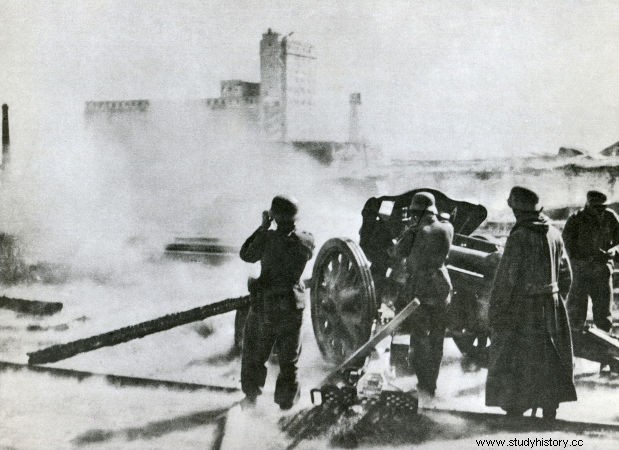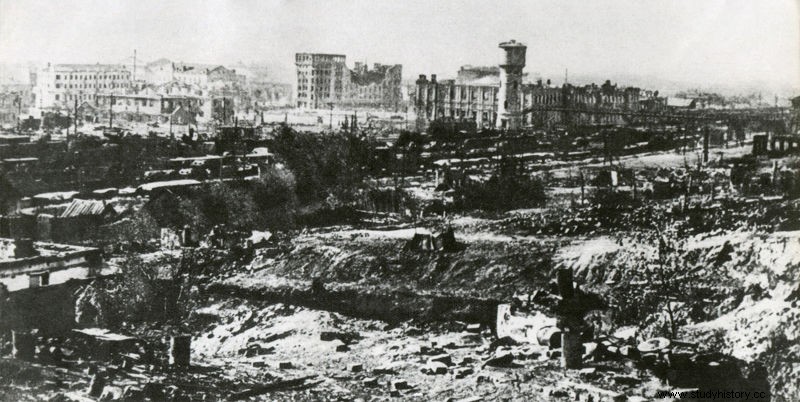
The Battle of Stalingrad it was the biggest battle fought during the Second World War. It took place between the German and Soviet armies from July 1942 to February 1943 and resulted in the deaths of approximately two million people. The gigantic effort undertaken by the Soviets and the depletion of the strength of the German armies resulted in a Soviet victory fundamental to the fate of the conflict.
Background
The battle fought at Stalingrad was part of Operation Barbarossa, initiated by the Nazis in June 1941. Operation Barbarossa organized the invasion of the Soviet Union with three major targets:the city of Leningrad , Moscow (capital of the Soviet Union) and the industrial park of the Stalingrad region .
Operation Barbarossa was aimed at the conquest of the Soviet Union in a fulminating way, similar to what had happened in France. However, Germany's failure in this regard caused the conflicts in the Soviet Union to extend and become the main battlefront of the Germans.
The initial rapid advance turned into a slow and painful one. In mid-1942, the city of Stalingrad became a key objective for Adolf Hitler. The city was an important industrial park of the Soviet Union, it was on the banks of the Volga River and was the gateway to the Caucasus region, rich in ore and oil.
Battle of Stalingrad

Panorama of the city of Stalingrad in ruins during the battle fought there between 1942 and 1943
The Battle of Stalingrad officially began on July 17, 1942 . The approach of Nazi forces to the city resulted in a desperate evacuation of the population, which crossed the Volga River towards Russia's east. Command of German forces at Stalingrad was assigned to Friedrich Paulus .
The German attack on the city of Stalingrad began with a heavy bombardment charge by the Luftwaffe (German warplane). German attacks turned part of the city into ruins. The first major ground attack by the Germans took place on September 13, after Friedrich Paulus received an order from Hitler stipulating a deadline for the conquest of Stalingrad.
The conquest of Stalingrad became an obsession for Hitler, who mobilized various resources, concentrating them on attacks against the city. This severely hampered the German war effort on other fronts. Another controversial decision made by Hitler was considered crucial to the failure of German forces:to extend the German army's line over a very vast distance.
On Stalin's side, the defense of Stalingrad was also considered crucial and was handed over to Major General Vasily Chuikov . The Soviet Major General knew that the defense of the city must happen at all costs and, when questioned by Khrushchev (Communist Party commissar in the region), replied:“we will defend the city or we will die trying”|1| .
Furthermore, during the battle, an express order of Stalin was to prevent the growth of defeatism in the Soviet forces. Thus, all soldiers who retreated or deserted would be summarily executed . It is estimated that during the battle fought at Stalingrad around 13,500 Soviet soldiers were executed like traitors |2| .
The fighting in Stalingrad was bloody, and the reports reinforce the hellish situation experienced by those who lived and fought in the city. The battles were fought street by street, fighting house by house, block by block. Soviet reports said that Stalingrad was “ten times worse than hell” or that the destruction found there was “much worse than expected”|3| .
The situation of Soviet forces in Stalingrad was desperate, and the Soviets were on the verge of collapse. They resisted thanks to the daily arrival of armaments and new soldiers, who every day hurriedly crossed the Volga River. The situation was so desperate that reinforcements were sometimes forced to cross the river during the day – making them easy targets for German planes.
The strategy put together by the Soviets, despite being disorganized, had an effect. Chuikov opted to shorten the distances between the German and Soviet lines of fire. In addition, the ruins scattered around the city made it difficult for the Germans and their armored vehicles to advance. The condition of street-to-street combat was also a factor of difficulty for the Germans, as it prevented greater movements and strategic attacks on the flanks.
German defeat
Two Soviet offensives were organized at the turn of 1942 to 1943 and were successful in driving the Germans out of the city. There was also a third offensive, which was not successful. Either way, the Soviet offensive managed to drive the Germans out of the city's perimeter and cornered the troops led by Friedrich Paulus.
Friedrich Paulus requested permission from Hitler to retreat, however his request was denied. Paulus' force, which consisted of some 200,000 soldiers exhausted by the war effort, was then condemned by Hitler's denial. Another German force in the region, led by Erich von Manstein and unable to continue resisting, retreated.
The surrender of German soldiers who had remained in Stalingrad took place on 2 February 1943 . After months of fierce fighting, the Soviets emerged victorious. The defeated Germans began its decadence, which lasted until 1945. Altogether, about 2 million people died during the fighting held at Stalingrad.
After the Battle of Stalingrad, the situation between the forces was reversed. Not only did Soviet industrial production greatly exceed German capacity, the number of new battle-ready Soviet soldiers increased, while Germany saw its cadres decline. This can be seen in the statement by Max Hastings:
The power of the Soviet Union and its armies grew rapidly as the strength of the invaders waned. In 1942, Germany produced only 4,800 armored vehicles, while Russia produced 24,000. […] In that year [1942], Russia still manufactured 21,700 aircraft against 14,700 German units. The Red Army employed six million soldiers, supported by 516,000 men of the NKVD [Soviet secret police]|4| .
|1| BEEVOR, Antony. The Second World War. Rio de Janeiro:Record, 2015, p. 404.
|2| HASTINGS, Max. Hell:the world at war 1939-1945. Rio de Janeiro:Intrinsic, 2012, p. 329.
|3| Ditto, p. 328.
|4| Ditto, p. 341.
Take the opportunity to check out our video lesson related to the subject:
